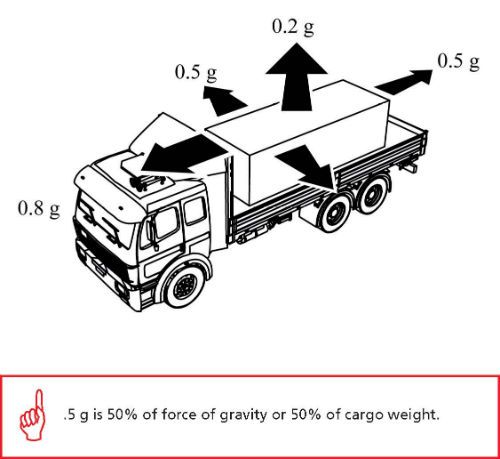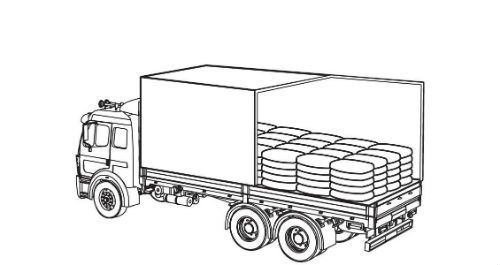Note: Your are not logged in. We can not keep your scores or track your progress unless you Register and Log In
New York State Metal Coil Endorsement Securement Manual
SECTION 1: FUNDAMENTALS OF CARGO SECUREMENT
Guiding Principle:
Public safety requires that METAL COILS and other cargo being transported on the highway must remain on or within the vehicle under normal driving conditions. The purpose of the standard is:
- To make highways safer.
- To prevent damage to cargo
Consequences for Drivers Who Do Not Follow the Standard:
- Delay of trip due to roadside enforcement activity.
- Possible accident resulting in personal injury or death.
- Financial losses to the driver and carrier, such as: loss of shipment, criminal or civil prosecution, increase in insurance rates, clean-up costs after the accident.
- Damage to cargo.
When to Apply the Standard:
Apply the standard when securing cargo to be transported on a highway by commercial vehicles:
-
Cargo Type:
For cargo and dangerous goods/hazardous materials, including equipment carried for vehicle operation and the contents of intermodal containers.
-
Vehicle Type:
Vehicle Type - for commercial vehicles (trucks, truck tractors, semitrailers, full trailers and tractor-pole trailers) with a gross vehicle weight rating of more than 4,500 kgs. / 10,000 lbs.
General Requirements of the Standard:
Cargo must be contained or secured so it does not:
- Leak
- Spill
- Blow
- Fall from or through
- Become dislodged
- Swing or shift, making the vehicle unstable
Performance Criteria for Securement Systems:
Part I: Cargo Securement Performance Criteria
The standard provides the minimum amount of force that cargo should be expected to withstand, in each direction, as shown below.
These minimum force requirements, called the “performance criteria”, were determined after extensive testing. The securement system MUST be capable of resisting these forces, as shown below.
- The forward force (80% of the cargo weight) represents braking while driving straight ahead.
- The rearward force (50% of the cargo weight) represents vehicle acceleration or braking in reverse.
- The side-to-side or lateral force (50% of the cargo weight) represents traveling on a curve, ramp or changing lanes.
- The vertical force (20% of the cargo weight)) represents cargo vibration during transport. This requirement is satisfied when the cargo is "Fully Contained"

The performance criteria may also be expressed in terms of acceleration, which is shown at right (“g” is the term used for gravity, and represents acceleration or deceleration).
- 0.8 g deceleration in the forward direction.
- 0.5 g deceleration in the rearward direction.
- 0.5 g acceleration in a side-to-side or lateral direction.
- 0.2 g vertical acceleration.
EXAMPLE: If a steel coil weighs 10,000 lbs., the load securement must provide 8,000 lbs. of securement to prevent movement in the forward direction, which is expressed as 80% of the cargo weight (or 0.8 g).
"Fully Contained" Cargo:

"Fully contained" means that the cargo is placed against a vehicle structure of adequate strength or other cargo so that it cannot shift or tip. Cargo that fills a sided vehicle of adequate strength is considered fully contained.
PART II - Performance Criteria for Components of a Securement System
Each component of the cargo securement system should not exceed its Working Load Limit (WLL), when at maximum force. The Working Load Limit is the maximum load that may be applied to a component of a cargo securement system during normal service; it is usually assigned by the manufacturer of the component.
Each force in the performance criteria is to be applied separately to the securement system to determine if it is compliant.
 Cargo Securement Terms That Truck Drivers Should Know:
Cargo Securement Terms That Truck Drivers Should Know:
-
Working Load Limit (WLL):
The maximum load that may be applied to a component of a cargo securement system during normal service, usually assigned by the manufacturer of the component.
-
g:
The acceleration due to gravity, 9.823 m/sec2 (32.2 ft/sec2). For cargo securement purposes it is expressed as a percentage of cargo weight, i.e. .5g is 50% of force of gravity or 50% of cargo weight.
-
Contained:
Cargo is contained if it fills a sided vehicle, and every article is in contact with or sufficiently close to a wall or other articles so that it cannot shift or tip if those other articles are also unable to shift or tip.
-
Tiedown:
A combination of securing devices which form an assembly that attaches cargo to, or restrains cargo on, a vehicle or trailer, and is attached to anchor point(s).
Multiple-Choice Questions:
The cargo securement standard applies to commercial vehicles weighing more than:
- 26,001 lbs
- 5,000 lbs
- 4,500 lbs
- 10,000 lbs
Vehicle Type:
Vehicle Type - for commercial vehicles (trucks, truck tractors, semitrailers, full trailers and tractor-pole trailers) with a gross vehicle weight rating of more than 4,500 kgs. / 10,000 lbs.
.5g is equal to what?
- 5% of cargo weight.
- 100% of cargo weight.
- 50% of cargo weight.
- 5,000 lbs.
g:
The acceleration due to gravity, 9.823 m/sec2 (32.2 ft/sec2). For cargo securement purposes it is expressed as a percentage of cargo weight, i.e. .5g is 50% of force of gravity or 50% of cargo weight.
A steel coil weighing 21,000 lbs requires how much securement against forward movement?
- 10,000 lbs
- 21,000 lbs
- 10,500 lbs
- 16,800 lbs
- The forward force (80% of the cargo weight) represents braking while driving straight ahead.
- The rearward force (50% of the cargo weight) represents vehicle acceleration or braking in reverse.
- The side-to-side or lateral force (50% of the cargo weight) represents traveling on a curve, ramp or changing lanes.
- The vertical force (20% of the cargo weight)) represents cargo vibration during transport. This requirement is satisfied when the cargo is "Fully Contained"
"Fully Contained" means:
- Cargo is placed against a vehicle structure of adequate strength or other cargo so that it cannot shift or tip.
- A structure, device, or another substantial article placed against or around an article to prevent horizontal movement of the article.
- A combination of securing devices which form an assembly that attaches cargo to, or restrains cargo on, a vehicle or trailer, and is attached to anchor point(s).
- A vehicle especially built and fitted with locking devices for the transport of intermodal containers.
"Fully contained" means that the cargo is placed against a vehicle structure of adequate strength or other cargo so that it cannot shift or tip. Cargo that fills a sided vehicle of adequate strength is considered fully contained.
A securement system must be capable of resisting how much lateral (side-to-side) force, at minimum?
- 20% of the cargo weight
- 100% of the cargo weight
- 50% of the cargo weight
- 80% of the cargo weight
- The forward force (80% of the cargo weight) represents braking while driving straight ahead.
- The rearward force (50% of the cargo weight) represents vehicle acceleration or braking in reverse.
- The side-to-side or lateral force (50% of the cargo weight) represents traveling on a curve, ramp or changing lanes.
- The vertical force (20% of the cargo weight)) represents cargo vibration during transport. This requirement is satisfied when the cargo is "Fully Contained"
A combination of securing devices which form an assembly that attaches cargo to, or restrains cargo on, a vehicle or trailer, and is attached to anchor point(s) is a:
- Void Filler
- Tiedown
- Working Load Limit
- Edge Protector
Tiedown:
A combination of securing devices which form an assembly that attaches cargo to, or restrains cargo on, a vehicle or trailer, and is attached to anchor point(s).
Working Load Limit (WLL)is defined as:
- The summation of the working load limits or restraining capacity of all devices used to secure an article on a vehicle.
- The maximum load that may be applied to a component of a cargo securement system during normal service, usually assigned by the manufacturer of the component.
- The depression formed between two cylindrical articles when they are laid with their eyes horizontal and parallel against each other.
- A combination of securing devices which form an assembly that attaches cargo to, or restrains cargo on, a vehicle or trailer, and is attached to anchor point(s).
Working Load Limit (WLL):
The maximum load that may be applied to a component of a cargo securement system during normal service, usually assigned by the manufacturer of the component.
Complete!
You can Return To The Table Of Contents







 TT On Facebook
TT On Facebook